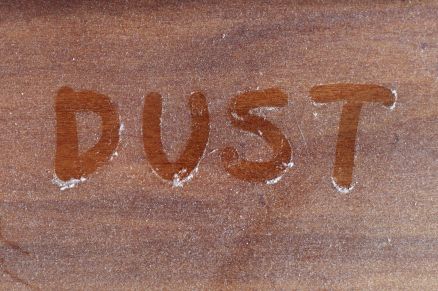No one likes dust: it’s unsightly, unhealthy, and downright disastrous if you or a family member suffers from allergies or asthma. Dust – of both the indoor and outdoor variety – is a natural occurrence, but a mostly unwelcome one.
Believe it or not, the particular dust in your home is customized, by none other than you and those who live in your house with you (both humans and four-legged friends). Varying factors like climate, your home’s building materials, the total number of occupants, cooking habits, cleaning maintenance and presence of smokers can all play into the amount and type of dust in your home.
Even so, according to post on Time.com, dust in general “consists of some combination of shed bits of human skin, animal fur, decomposing insects, food debris, lint and organic fibers from clothes, bedding and other fabrics, tracked-in soil, soot, particulate matter from smoking and cooking, and, disturbingly, lead, arsenic and even DDT.”
“As a general rule, the majority of household dust — about 60% — comes from outside, through windows, doors, vents and, significantly, on the soles of your shoes. Smaller dust particles — from 28 to 49 microns, or thousandths of a millimeter — tend to stay on your shoes. The rest is shaken off inside.”
“Dust in our homes,” says Paloma Beamer, a professor of environmental policy at the University of Arizona, “especially deep dust in our carpets and furniture, is a conglomerate of substances over the life of the home and can provide a historical record of chemicals that have entered it.”
While no home can ever been 100% dust-free, it is possible to significantly reduce the dust in your home by instituting more effective cleaning habits and investing in the right machines to clean your home. Here are our top 10 tips for reducing dust in your home:
-
Close those windows.
While occasionally opening a window can be a good idea to circulate in clean air, you’re also ushering in pollen, mold spores, and various airborne pollutants into your immediate breathing space. -
Get a doormat.
It might not seem like doormats do much, but the ones with bristles are actually quite good at trapping dirt particles from shoes, thus keeping it from ever entering your home. -
Give Fido and Fifi a bath.
Hopefully the dog won’t object (although your cat probably will) – but regular baths for your pet can mean a decrease in dust and pet dander. Since dead skin cells and hair are both components of dust, removing both from your pet can mean a cleaner home and a better smelling critter! -
Invest in a top-of-the-line air purifier.
A good air purifier can take dust out of the air, trap it and keep it out of circulation. IQAir’s New Edition HealthPro air purifier features revolutionary HyperHEPA filtration, which is proven to capture particles 100 times smaller, down to 0.003 microns. Its triple seal design guards against air leakage, all without adding ozone, ions, UV or chemicals into the air you breathe. -
Break out the mop.
Believe it or not, regular mopping and wiping down surfaces with a damp cloth can help eliminate 80-90% of the dust in your home. No added chemicals are needed – just a damp mop or cloth and plain water will do. Also, wiping down any sticky surface (tables, countertops, kids’ toys) will help repel dust instead of attracting it. -
Wash those pillows.
Washing your sheets on a weekly basis is also a great way to reduce dust, since it eliminates dead skin, dander and dust mites that live there. While you’re at it, clean your pillows too. You can wash them in a machine, by hand or take them to the dry cleaners. Either way, a proper washing can get rid of all the dust (and sweat!) that can end up in your pillow. -
Wipe down your blinds and fan blades.
If you’re one of those people who runs an overhead fan throughout the year, you know what gunk can accumulate on those blades when you finally turn it off. Blinds, with all their surfaces and crevices, can also be a haven for dust. Use a damp cloth or a dry porous cleaning cloth to clean both. -
Vacuum regularly.
Pulling ground-in dirt, pet hair and dead skin flakes out of your carpet and off floors goes a long way to cutting your household dust. Be sure to use a vacuum with a HEPA filter, so that the particles whipped up by the vacuum don’t reenter your air space. The Miele Complete C3 Limited Edition vacuum cleaner features an Active HEPA filter and Air Clean Sealed System, and maintains pristine indoor air quality as 99.9% of lung damaging particles are retained inside the vacuum’s filtration system. -
Replace filters.
A clogged, dirty filter ends up sending the very particles you hoped to avoid back into your air supply. Make sure you replace them: once every 4 to 6 months for regular households, and once every 1-3 months if you have pets or someone who suffers from allergies or asthma. -
Give your rug a good beating.
The fewer carpets and rugs you have in your home, the better (dust-wise), since both provide an ideal place for dust to get trapped…and stay. For area rugs, take them outdoors, hang them over a clothesline and give them a good beating: you’ll be amazed (and maybe a little disgusted) at what comes out.

